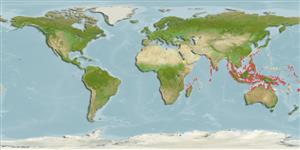Common names from other countries
Environment: milieu / climate zone / depth range / distribution range
Ecologia
marinhas; estuarina associadas(os) a recifes; intervalo de profundidade 0 - 5 m (Ref. 90102). Tropical; 23°C - 28°C (Ref. 13614); 35°N - 20°S
Western Pacific: Andaman Islands to Vanuatu, north to Japan, south to New Caledonia. Occurs in the Mekong delta, but possibly may be found as far upstream as the tidal zone (Ref. 12693).
Tamanho / Peso / Idade
Maturity: Lm ? range ? - ? cm
Max length : 16.2 cm TL macho/indeterminado; (Ref. 11344)
Espinhos dorsais (total) : 7; Raios dorsais moles (total) : 10 - 11; Espinhos anais: 1; Raios anais moles: 9 - 10; Vértebras: 26. Ground color brown, darker dorsally; dusky spots proximally on pectoral fin; blackish pelvic fins. 10 or more predorsal scales. Cheeks and opercula fully scaled. Spines of 1st dorsal fin elongated into filaments. Differs from E. belissimus by having fewer predorsal scales and slightly different details of coloration (Ref. 1602); characterized further by having pectoral rays 16-18; rounded caudal fin; longitudinal scale series 30-33; ctenoid scales except cycloid on nape and isthmus; depth of body 3.6-4.0 in SL (Ref. 90102).
Solitary or in groups (Ref. 90102). Inhabits muddy bottoms of shallow, turbid marine to brackish coastal inlets and estuaries. Also lives in shallow coastal waters, large tidal pools, mangroves, siltty lagoons and brackish lakes (Ref. 48637).
Life cycle and mating behavior
Maturities | Reprodução | Spawnings | Egg(s) | Fecundities | Larvas
Murdy, E.O., 1985. A review of the gobiid fish genera Exyrias and Macrodontogobius, with description of a new species of Exyrias. Indo-Pac. Fish. (10):14 p. (Ref. 403)
Categoria na Lista Vermelha da IUCN (Ref. 130435)
CITES (Ref. 128078)
Not Evaluated
Ameaça para o homem
Harmless
Utilização humana
Pescarias: espécies comerciais; Aquário: Espécies comerciais
Ferramentas
Relatórios especiais
Descarregue XML
Fontes da internet
Estimates based on models
Preferred temperature (Ref.
115969): 26.2 - 29.3, mean 28.7 (based on 2386 cells).
Phylogenetic diversity index (Ref.
82804): PD
50 = 0.5312 [Uniqueness, from 0.5 = low to 2.0 = high].
Bayesian length-weight: a=0.01023 (0.00477 - 0.02194), b=3.02 (2.84 - 3.20), in cm Total Length, based on LWR estimates for this (Sub)family-body shape (Ref.
93245).
Nível Trófico (Ref.
69278): 3.5 ±0.37 se; based on food items.
Resiliência (Ref.
120179): Elevada, tempo mínimo de duplicação da população menor que 15 meses (Preliminary K or Fecundity.).
Fishing Vulnerability (Ref.
59153): Low vulnerability (10 of 100).
